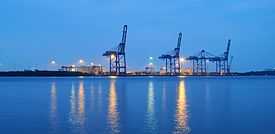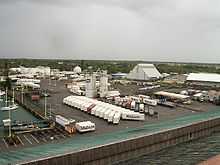Port














A port is a location on a coast or shore containing one or more harbors where ships can dock and transfer people or cargo to or from land. Port locations are selected to optimize access to land and navigable water, for commercial demand, and for shelter from wind and waves. Ports with deeper water are rarer, but can handle larger, more economical ships. Since ports throughout history handled every kind of traffic, support and storage facilities vary widely, may extend for miles, and dominate the local economy. Some ports have an important military role.
Distribution
Ports often have cargo-handling equipment, such as cranes (operated by longshoremen) and forklifts for use in loading ships, which may be provided by private interests or public bodies. Often, canneries or other processing facilities will be located nearby. Some ports feature canals, which allow ships further movement inland. Access to intermodal transportation, such as trains and trucks, are critical to a port, so that passengers and cargo can also move further inland beyond the port area. Ports with international traffic have customs facilities. Harbour pilots and tugboats may maneuver large ships in tight quarters when near docks.
Types
The terms "port" and "seaport" are used for different types of port facilities that handle ocean-going vessels, and river port is used for river traffic, such as barges and other shallow-draft vessels.
Inland port
An Inland port is a port on a navigable lake, river (fluvial port), or canal with access to a sea or ocean, which therefore allows a ship to sail from the ocean inland to the port to load or unload its cargo.
Fishing port
A fishing port is a port or harbour for landing and distributing fish. It may be a recreational facility, but it is usually commercial. A fishing port is the only port that depends on an ocean product, and depletion of fish may cause a fishing port to be uneconomical. In recent decades, regulations to save fishing stock may limit the use of a fishing port, perhaps effectively closing it.
Dry port
A dry port is an inland intermodal terminal directly connected by road or rail to a seaport and operating as a centre for the transshipment of sea cargo to inland destinations.[1]
Warm-water port
A warm water port is one where the water does not freeze in winter time. Because they are available year-round, warm water ports can be of great geopolitical or economic interest. Such settlements as Vostochny Port,[2] Murmansk and Petropavlovsk-Kamchatsky in Russia, Odessa in Ukraine, Kushiro in Japan and Valdez at the terminus of the Alaska Pipeline owe their very existence to being ice-free ports.
Seaport
A seaport is further categorized as a "cruise port" or a "cargo port". Additionally, "cruise ports" are also known as a "home port" or a "port of call". The "cargo port" is also further categorized into a "bulk" or "break bulk port" or as a "container port".
Cruise home port
A cruise home port is the port where cruise-ship passengers board (or embark) to start their cruise and disembark the cruise ship at the end of their cruise. It is also where the cruise ship's supplies are loaded for the cruise, which includes everything from fresh water and fuel to fruits, vegetable, champagne, and any other supplies needed for the cruise. "Cruise home ports" are a very busy place during the day the cruise ship is in port, because off-going passengers debark their baggage and on-coming passengers board the ship in addition to all the supplies being loaded. Currently, the Cruise Capital of the World is the Port of Miami, Florida, closely followed behind by Port Everglades, Florida and the Port of San Juan, Puerto Rico.
Port of call
A port of call is an intermediate stop for a ship on its sailing itinerary, which may include up to half a dozen ports. At these ports, a cargo ship may take on supplies or fuel, as well as unloading and loading cargo. But for a cruise ship, it is their premier stop where the cruise lines take on passengers to enjoy their vacation.
Cargo port
Cargo ports, on the other hand, are quite different from cruise ports, because each handles very different cargo, which has to be loaded and unloaded by very different mechanical means. The port may handle one particular type of cargo or it may handle numerous cargoes, such as grains, liquid fuels, liquid chemicals, wood, automobiles, etc. Such ports are known as the "bulk" or "break bulk ports". Those ports that handle containerized cargo are known as container ports. Most cargo ports handle all sorts of cargo, but some ports are very specific as to what cargo they handle. Additionally, the individual cargo ports are divided into different operating terminals which handle the different cargoes, and are operated by different companies, also known as terminal operators or stevedores.
Access
Ports sometimes fall out of use. Rye, East Sussex, was an important English port in the Middle Ages, but the coastline changed and it is now 2 miles (3.2 km) from the sea, while the ports of Ravenspurn and Dunwich have been lost to coastal erosion. Also in the United Kingdom, London, on the River Thames, was once an important international port, but changes in shipping methods, such as the use of containers and larger ships, put it at a disadvantage.
Environmental effect
There are several initiatives to decrease ports' environmental effect. These include the World Ports Climate Initiative, the African Green Port Initiative and EcoPorts.[3]
Ports of the World
Africa
Asia
For details on East Asian ports, see the List of East Asian ports.
North America
The largest ports are Los Angeles in the U.S., Manzanillo in Mexico and Vancouver in Canada. Panama also has the Panama Canal that connects the Pacific and Atlantic Ocean, and is a key conduit for international trade.
For details on all North American ports, see the List of North American ports.
The ports of the United States handle more than 2 billion metric tons of domestic and import/export cargo annually. American ports are responsible for moving over 99 percent of the country's overseas cargo.
For details on U.S. Ports, see the List of ports in the United States.
See also
Water port topics
- Bandar (Persian word for "port" or "haven")
- Marina - port for recreational boating
- Port operator
- Ship transport
Other types of ports
Lists
- List of seaports
- World's busiest port
- List of world's busiest transshipment ports
- List of world's busiest port regions
- List of busiest container ports
- List of North American ports
- List of ports in the United States
- List of East Asian ports
- Sea rescue organisations
References
- ↑ "Feasibility Study on the network operation of Hinterland Hubs (Dry Port Concept) to improve and modernise ports' connections to the hinterland and to improve networking". InLoc. January 2007. Retrieved 2008-03-10.
- ↑ "Vostochny Port JSC, Geography, Location". Vostochny Port website. 2007. Retrieved 13 December 2012. "... Vostochny Port is located in the south of Primorsky Region, in the southeast of Nakhodka bay, in Vrangel bay. This is unique natural harbor is no ice restrictions even in severe winters. ..."
- ↑ EOS magazine, 6,2012
External links
- Port Industry Statistics, American Association of Port Authorities
- Information on yachting facilities at 1,613 ports in 191 countries from Noonsite.com
- Social & Economic Benefits of PORTS from "NOAA Socioeconomics" website initiative
- Antunes, Cátia: Early Modern Ports, 1500-1750, European History Online, Mainz: Institute of European History, 2011, retrieved: November 2, 2011.





